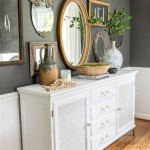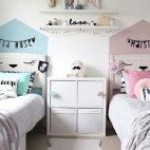Decorating Ideas To Make Small Rooms Look Bigger
Maximizing space in a small room requires a strategic approach to decorating. By carefully considering color palettes, furniture selection, lighting, and storage solutions, a room can appear larger and more inviting, despite its limited square footage. The key is to create a sense of visual openness and to minimize clutter, allowing the eye to travel freely throughout the space.
Strategic Color Selection for Enhanced Spaciousness
Color plays a pivotal role in how we perceive space. Lighter colors reflect more light, making a room feel brighter and more open. Conversely, darker colors tend to absorb light, which can make a room feel smaller and more enclosed. Therefore, opting for lighter shades, particularly on the walls and ceiling, is a fundamental principle in making a small room appear larger.
White, in its various shades, is the most commonly recommended color for expanding a room visually. It reflects light effectively and creates a clean, airy atmosphere. However, other light and neutral colors can be equally effective. Soft grays, pale blues, creams, and even muted greens can provide a sense of spaciousness while adding a touch of personality and warmth. Consider the natural light available in the room when choosing a color. A room with limited natural light may benefit from a warmer shade to prevent it from feeling cold or sterile.
While lighter colors are generally preferred for the walls, the ceiling should also be painted in a light or white hue. Painting the ceiling a shade lighter than the walls can create the illusion of height, making the room feel taller. Avoid dark colors on the ceiling in small rooms, as they tend to visually lower the ceiling height, creating a more cramped feeling. A gloss or semi-gloss finish on the ceiling can also help reflect more light, further enhancing the sense of spaciousness.
Introducing color accents through accessories, such as throw pillows, artwork, and rugs, can add depth and visual interest without compromising the overall sense of spaciousness. These accents can be in bolder colors or patterns, providing pops of color against the neutral backdrop. Limiting the number of accent colors and ensuring they complement each other is crucial for maintaining a cohesive and uncluttered feel.
Monochromatic color schemes, where different shades of the same color are used throughout the room, can also be effective in creating a sense of unity and flow. This approach avoids harsh contrasts that can break up the space visually, making it feel smaller. Using varying textures within a monochromatic scheme can add depth and interest without introducing additional colors.
Furniture Selection and Arrangement for Optimal Functionality
Careful furniture selection is paramount in small spaces. Choosing furniture that is appropriately scaled for the room and serves multiple purposes can significantly improve both functionality and aesthetic appeal. Overly large or bulky furniture can overwhelm a small room, making it feel cramped and cluttered. Opting for smaller, more streamlined pieces is essential for maximizing space.
Multi-functional furniture is a particularly valuable asset in small rooms. Sofa beds, storage ottomans, and coffee tables with built-in storage can provide both seating and storage, reducing the need for additional bulky furniture. Choosing furniture with hidden compartments or drawers can help keep clutter out of sight and maximize the use of vertical space.
Furniture with exposed legs, such as sofas and chairs with slender legs, can create a sense of lightness and airiness. This design allows more of the floor to be visible, which makes the room feel more open. Avoid furniture that sits directly on the floor, as it can appear heavy and bulky. Transparent furniture, such as acrylic chairs or glass tables, can also help create the illusion of more space by allowing light to pass through them and minimizing visual obstruction.
The arrangement of furniture is just as important as the selection. Avoid pushing all furniture against the walls, as this can actually make the room feel smaller and more boxy. Instead, create a focal point in the room and arrange the furniture around it. This can be a fireplace, a large window, or a piece of artwork. Leaving some space between furniture pieces and the walls allows the eye to travel more freely and creates a more open and inviting feeling.
Consider using vertical space effectively by incorporating tall bookshelves or shelving units. These can provide ample storage without taking up valuable floor space. When arranging furniture, prioritize functionality and flow. Ensure that there is enough space to move comfortably around the room and that pathways are clear and unobstructed. Avoid cluttering surfaces with excessive accessories, as this can make the room feel smaller and more disorganized.
Maximizing Light and Mirrors for Enhanced Visual Depth
Light is a powerful tool for expanding the perceived size of a room. Both natural and artificial light can be used strategically to create a brighter and more open atmosphere. Maximizing natural light is the first step. Ensure that windows are clean and unobstructed, allowing as much sunlight as possible to enter the room. Avoid heavy curtains or blinds that block natural light. Instead, opt for sheer curtains or blinds that allow light to filter through while still providing privacy.
Strategically placed mirrors can create the illusion of depth and expand the perceived size of a room. Mirrors reflect light and visually double the space, making a small room feel significantly larger. Placing a large mirror on a wall can create a focal point and make the room feel more open. Mirrors can also be used to reflect natural light from windows, further brightening the room.
Consider the placement of mirrors carefully. Placing a mirror opposite a window can reflect the view outside, creating the illusion of an additional window. Placing a mirror in a hallway or narrow space can make it feel wider and more spacious. Avoid placing mirrors in areas that reflect clutter or unattractive views, as this can detract from the overall aesthetic appeal.
In addition to mirrors, artificial lighting plays a crucial role in illuminating a small room. A combination of ambient, task, and accent lighting can create a layered and well-lit space. Ambient lighting, such as overhead fixtures or recessed lighting, provides general illumination for the room. Task lighting, such as desk lamps or reading lamps, provides focused light for specific activities. Accent lighting, such as spotlights or picture lights, highlights specific features or artwork in the room.
Avoid using a single overhead light, as this can create harsh shadows and make the room feel smaller. Instead, use a combination of different light sources to create a more balanced and inviting atmosphere. Opt for light fixtures that are appropriately scaled for the room and that do not take up too much space. Wall sconces and pendant lights can be good alternatives to floor lamps, as they save floor space and provide ample illumination. Utilizing lamps with dimmer switches can also provide flexibility in adjusting the brightness of the room to suit different moods and activities, creating a more comfortable and adaptable space.

Small Living Room Ideas

How To Make A Small Room Look Bigger Joyful Derivatives

11 Tricks To Make A Small Home Appear Bigger Bedroom Decor Inspiration Room Design

18 Small Bedroom Ideas How To Make Your Room Look Bigger Extra Space Storage

Small Space Decorating Ideas How To Make A Room Look Bigger
Interior Decorators Reveal 3 Ways To Make A Small Room Look Bigger

Remodeling Tips 7 Ways To Make A Small Room Feel Larger

How To Make Your Living Room Look Bigger

How To Make A Small Room Look Bigger

How To Make A Small Bedroom Look Bigger Unique Blog
Related Posts







